In today’s world, where screens dominate a child’s daily routine and outdoor playtime continues to shrink, many parents, educators, and childcare providers face a common challenge: creating a safe, engaging, and developmental space for children to play. The lack of access to a proper outdoor play area limits children’s physical activity and hampers their ability to develop essential social, emotional, and motor skills.
Children are indoors for hours, losing the opportunity to explore, create, and connect with nature. Without a well-designed play area, kids miss out on the benefits of fresh air, sensory exploration, and unstructured play that are critical to their growth. Parents worry about safety, daycares struggle to provide engaging activities, and schools wonder how to combine fun with education in their outdoor play ideas. Moreover, finding age-appropriate play spaces—like a safe play area for infants or a stimulating outdoor play area for preschoolers—is even more challenging for toddlers and infants.
You can create a magical outdoor play area with the right approach that balances fun, safety, and developmental benefits. Whether it’s a vibrant play area for kids filled with swings and slides, a natural-themed space like a natural outdoor area, or a creatively designed outdoor sensory play area, the possibilities are endless. This guide will walk you through every step of the process—covering everything from choosing the best materials (like outdoor rubber mats for play areas) to incorporating innovative features like outdoor water play areas, outdoor dramatic play areas, and more.
So, whether you’re a parent looking to create the perfect outdoor play area at home, a daycare provider seeking inspiration for a daycare outdoor play area, or an educator designing a kindergarten outdoor play area, this article will provide you with actionable ideas and expert tips to make your vision a reality. Let’s dive in and unlock the endless potential of outdoor play for children!
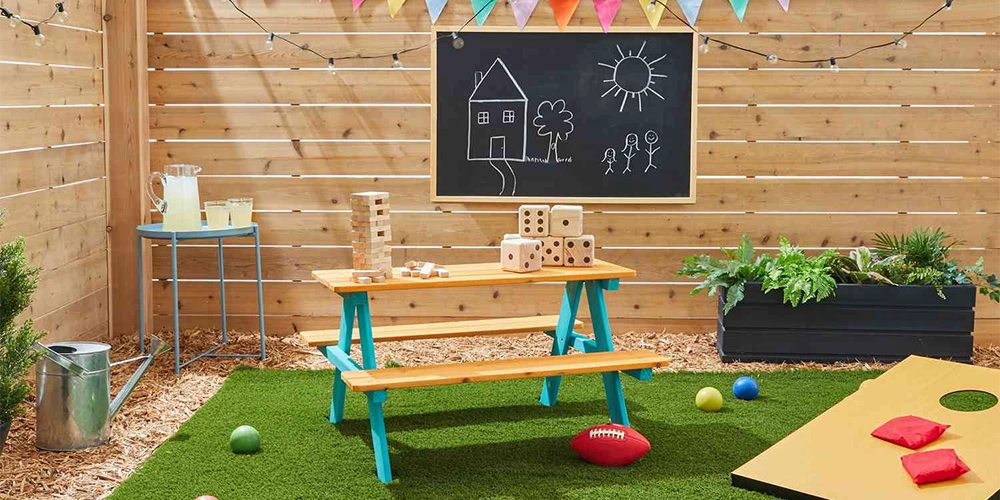
Why Outdoor Play Areas Are Crucial for Children
The importance of outdoor play areas lies in bridging the growing gap between children and the natural world. Historically, unstructured outdoor play was a central part of childhood, allowing kids to develop essential skills through exploration and experimentation. However, the rapid rise of urban living and digital entertainment has replaced this with sedentary lifestyles, contributing to health concerns such as obesity, decreased motor skills, and higher levels of anxiety. A thoughtfully designed outdoor play area restores this vital connection, allowing children to explore their surroundings freely, engage with peers, and develop resilience in a safe environment.
The lack of outdoor play opportunities for families, schools, and communities also impacts social bonds. A vibrant children’s outdoor play area provides more than just a space for fun—it serves as a gathering point for families, a tool for educational development, and a foundation for building stronger community ties. By integrating creative elements like natural outdoor play areas or stimulating features such as outdoor sensory play areas, these spaces encourage collaborative play and imaginative learning, fostering a sense of togetherness beyond childhood.
Importantly, outdoor play areas cater to children across all age groups and developmental stages. For infants and toddlers, spaces like an outdoor play area for infants or a daycare outdoor play area offer soft, secure environments for physical and sensory exploration. Preschoolers and older kids benefit from features like climbing walls, swings, or water play zones, which challenge their growing physical and mental abilities. These spaces are vital for childhood development and lay the groundwork for lifelong habits of physical activity, social interaction, and an appreciation for the environment.
By understanding the critical role of outdoor play areas in childhood, we can prioritize designing spaces that balance safety, creativity, and education. Whether for a home, school, or community, investing in an outdoor play area is not just a decision for the present—it’s a meaningful contribution to the future well-being of the next generation.
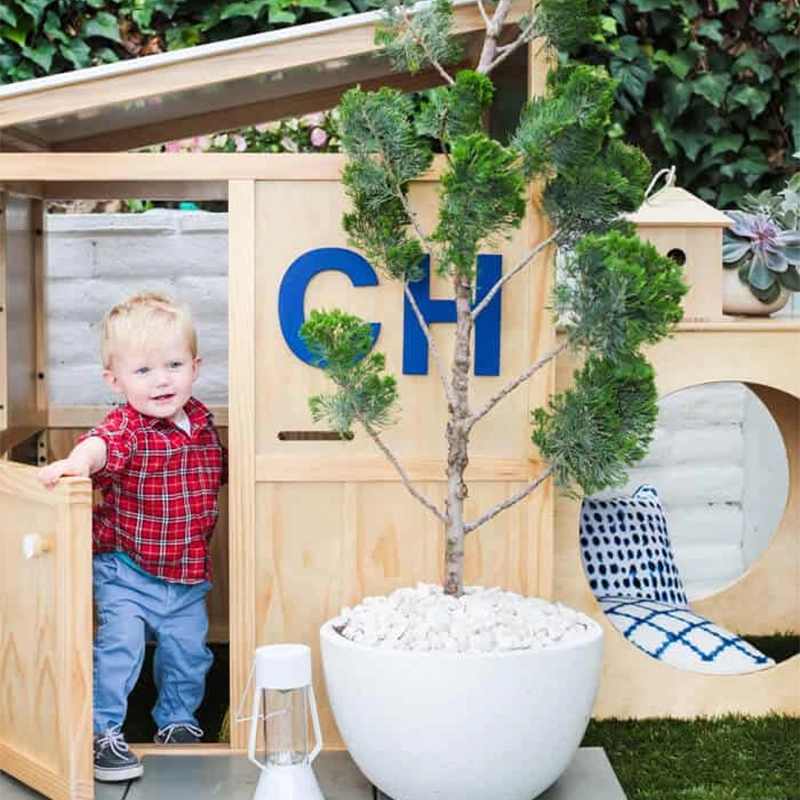
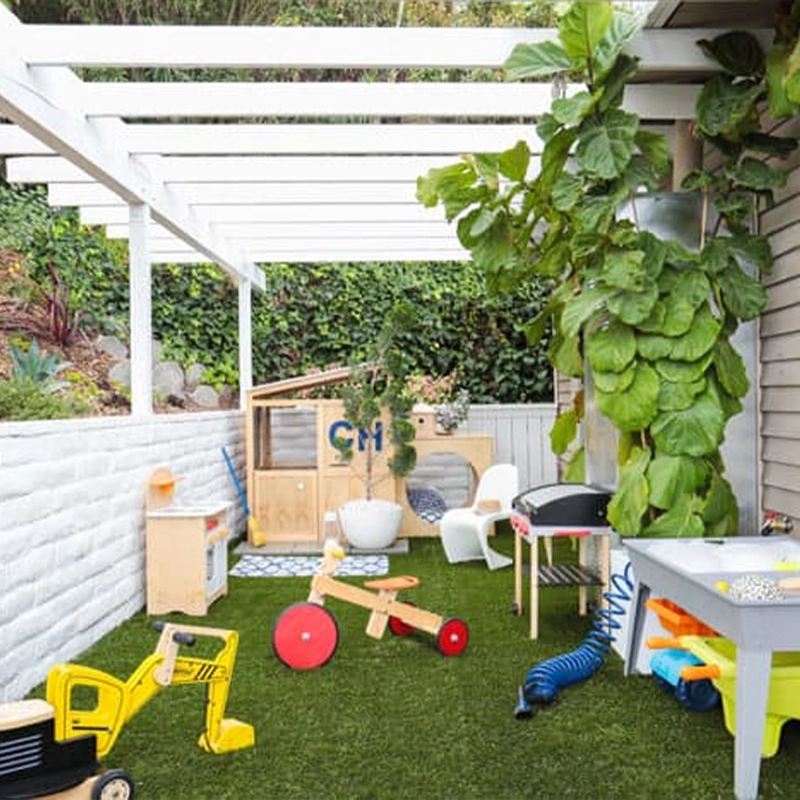
Benefits of an Outdoor Play Area for Kids
A well-designed outdoor play area offers countless benefits for children’s physical, mental, and social development. These spaces are more than just a place for kids to have fun—they are essential environments where children can explore, grow, and develop critical life skills. Let’s dive deeper into the specific benefits of an outdoor play area for kids that is tailored to various age groups and developmental needs.
Physical Development
Children are naturally energetic, and an outdoor play area provides the perfect outlet for them to engage in physical activity. Running, jumping, climbing, and balancing on equipment like monkey bars or swings helps develop gross motor skills, strength, and coordination. Features like slides, balance beams, and climbing frames in an outdoor play area for toddlers or preschoolers are especially effective for enhancing physical fitness.
Adding outdoor rubber mats for play areas ensures safety during these activities while allowing kids to explore without fear of injury. Moreover, activities like water play in an outdoor water play area, or sandbox play in a natural outdoor play area contribute to fine motor skill development as children use their hands to manipulate tools, sand, or water.
Mental and Cognitive GrowthThe unstructured nature of outdoor play encourages children to use their imagination and creativity. For example, a dramatic outdoor play area allows children to engage in pretend play, such as building houses or creating role-play scenarios. These activities stimulate critical thinking, problem-solving, and decision-making skills.
Additionally, features like a sensory outdoor play area enhance cognitive development by stimulating children’s senses. Whether it’s the sound of water splashing, the feel of sand between their fingers, or the scent of flowers in a natural outdoor play area, these sensory experiences provide a rich learning environment.
Social Development and Teamwork
An outdoor play area for kids is an excellent space for fostering social interaction. Group activities like playing on swings, sharing toys, or working together to build something in a construction outdoor play area teach children valuable lessons about teamwork, communication, and conflict resolution.
For daycares and schools, a dedicated daycare outdoor play area or kindergarten outdoor play area offers structured opportunities for children to interact with their peers in a supervised setting. These interactions help build confidence and empathy as children learn to navigate relationships and work collaboratively.
Emotional Well-Being and Stress Relief
Playing outdoors has been shown to reduce stress and improve mood in children. Being in an outdoor playing area, surrounded by natural elements, has a calming effect that helps children manage emotions and improve focus. Incorporating sensory features like water fountains or sand pits in an outdoor sensory play area can further enhance relaxation and emotional regulation.
Educational Benefits
Outdoor play can also be an excellent learning experience. Features like vegetable gardens, bird feeders, or water play zones in an outdoor play area provide hands-on educational opportunities. Children can learn about nature, physics (through water and sand play), and environmental stewardship in a fun, interactive way. Montessori-inspired designs, like those in a Montessori outdoor play area, combine play with education, fostering curiosity and self-guided learning.
Parents, educators, and caregivers can ensure children grow up healthier, happier, and more socially adept by creating an engaging outdoor play area. These spaces offer benefits that extend far beyond childhood, laying the foundation for a lifetime of learning, exploration, and joy.
Understanding Children’s Gross Motor Skills and Play
Many activities we label as “play” during early childhood play a crucial role in developing children’s gross motor skills. Gross motor skills involve the larger muscle groups for walking, running, and jumping. These skills are essential for everyday activities and overall physical development.
Outdoor play areas are ideal for children to develop their gross motor skills. Activities such as climbing, balancing, and skipping are fun and help strengthen muscles and improve coordination. By incorporating various elements into an outdoor play area, you can provide children with opportunities to practice and enhance these essential skills.
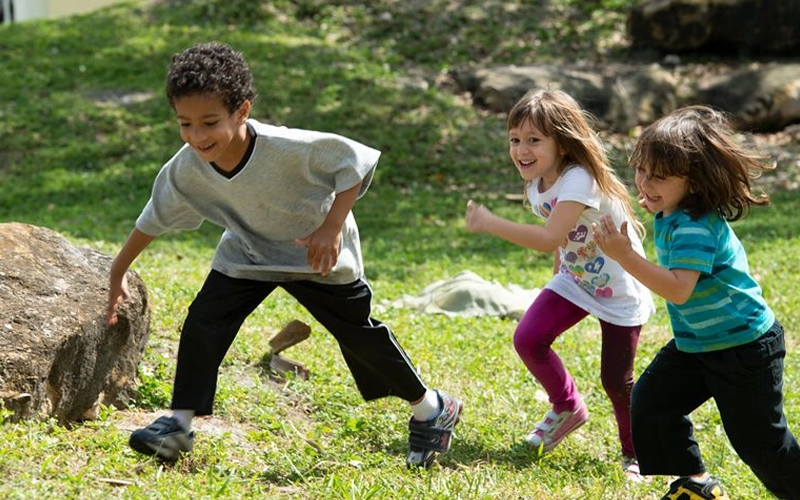
Walking and Running: Open spaces in an outdoor play area allow children to run freely. Pathways or tracks can encourage walking and running, helping to build endurance and improve cardiovascular health.
Climbing: Climbing structures like walls, ropes, and ladders are excellent for building upper body strength and enhancing coordination. These activities also challenge children to think critically and solve problems while navigating the structures.
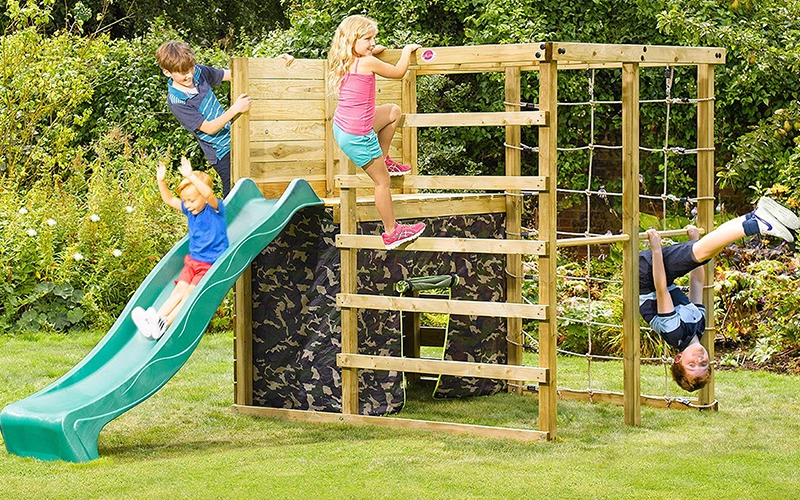
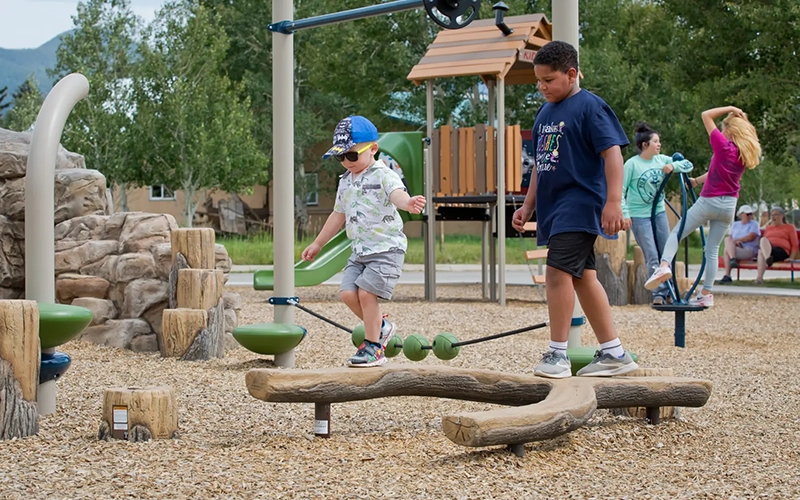
Balancing: Balance beams, stepping stones, and uneven surfaces help children develop core strength and stability. These features require children to focus on their movements and maintain balance, improving overall body control.
Core Strength: Equipment like swings, seesaws, and monkey bars engage the core muscles. These activities not only strengthen the core but also promote coordination and balance.
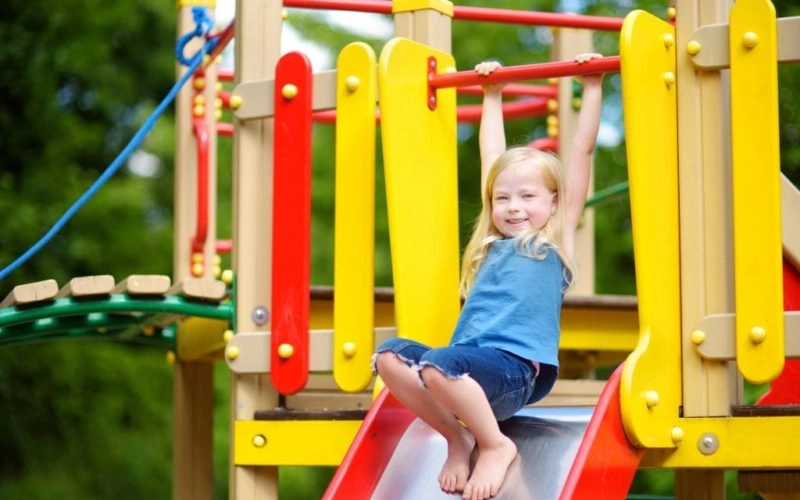
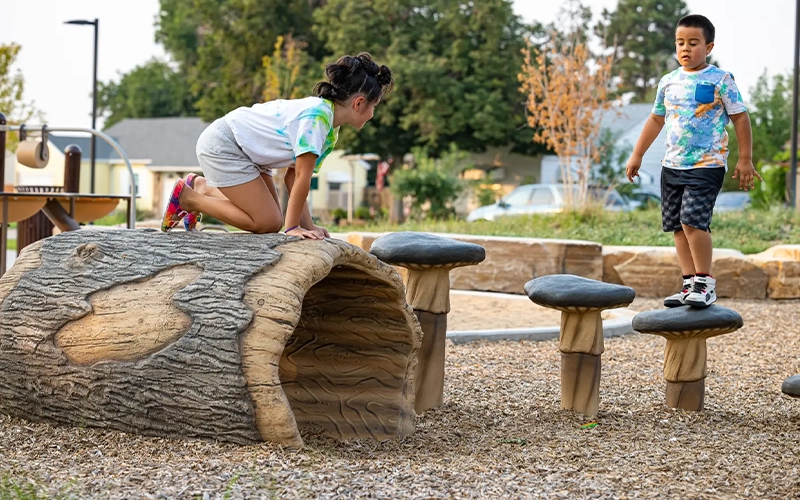
Flexibility: Features like tunnels, slides, and crawl spaces encourage children to stretch, bend, and move in various ways. These activities help improve flexibility and range of motion.
Skipping and Jumping: Skipping ropes, hopscotch grids, and trampolines are perfect for developing rhythm, coordination, and leg strength. These activities are also great for cardiovascular health and overall fitness.
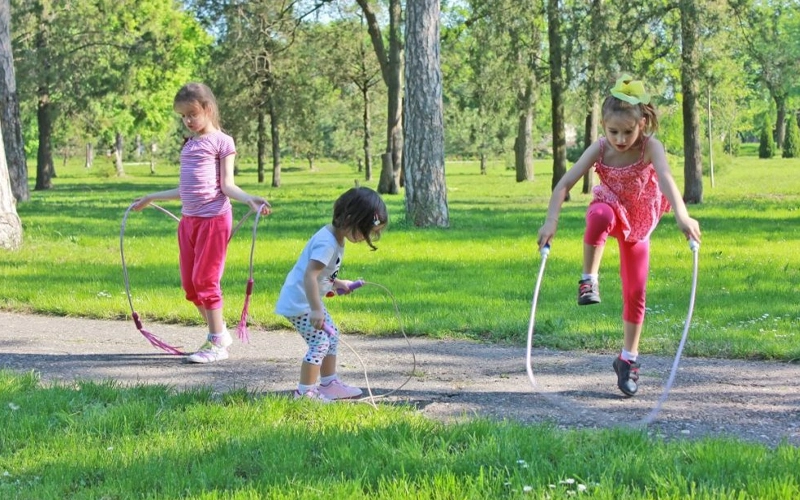
Outdoor play equipment designed to target specific gross motor skills can significantly enhance children’s physical abilities. For example, incorporating a climbing wall can help children develop upper body strength and coordination, while balance beams can improve stability and focus.
As children grow, their play needs evolve. Therefore, an effective outdoor play area should offer progressive challenges that cater to different age groups and skill levels. This ensures that all children can benefit from the play structures, whether they are just starting to walk or are ready to tackle more complex activities.
In conclusion, understanding and supporting the development of gross motor skills through well-designed outdoor play areas can provide children with the physical foundation they need for a healthy, active life. You can create an environment that promotes physical growth, coordination, and confidence by including diverse play structures and activities.
Key Elements of a Safe Outdoor Play Area
When designing an outdoor play area, safety is the top priority. A well-planned outdoor play area for kids ensures children can play freely without risking unnecessary injuries. Below are the key elements to consider when building a safe and engaging play area for children of all ages.
- Age-Appropriate Design
An outdoor play area should cater to the children’s specific developmental needs. For infants and toddlers, a dedicated outdoor play area for infants should include soft surfaces, age-appropriate toys, and low climbing structures to prevent falls. The design can consist of more challenging features like slides, swings, and balance beams for preschoolers.
In a daycare outdoor play area or nursery outdoor play area, it’s essential to separate play zones based on age groups to ensure safety. A good outdoor play area layout should also provide enough space for children to move freely without overcrowding.
- Safe Flooring Materials
The ground surface of an outdoor play area is a critical component of safety, and using outdoor rubber mats for play areas is one of the best ways to minimize injuries from falls. These mats provide cushioning and are weather-resistant, making them ideal for small home setups and large outdoor play areas in schools or daycares.
Sand or grass can be used for natural setups, but these should be well-maintained to avoid hazards like sharp objects or uneven surfaces.
- Durable and Non-Toxic Materials
All equipment in an outdoor play area should be made from durable, weather-resistant, and non-toxic materials. For example, a wooden outdoor play area not only looks natural but is also sturdy and long-lasting. However, ensuring the wood is treated to resist rot and splinters is essential.
Plastic and metal equipment should be checked regularly for wear and tear, especially in large outdoor play areas or play area outdoor setups exposed to extreme weather conditions.
- Proper Fencing and Boundaries
Fencing is essential for kids in any outdoor play area, especially in public spaces or daycares. It prevents children from wandering off and keeps out potential hazards like stray animals. For added safety, gates should be secure and childproof.
- Sun and Weather Protection
A covered outdoor play area is a great way to protect children from harsh sunlight or rain. Adding shade structures, such as canopies or pergolas, ensures the play area remains usable year-round. This is especially important for younger children in a daycare outdoor play area or outdoor play area for preschoolers, as their skin is more sensitive to sun exposure.
- Regular Maintenance and Inspections
Regular maintenance is crucial to keep an outdoor play area safe. Equipment should be inspected for wear and tear, and surfaces should be cleaned to remove debris or hazards. For natural areas, it’s essential to check for harmful plants, insects, or objects that could pose a risk to children.
By focusing on these key elements, you can create a safe, engaging, and developmentally appropriate outdoor play area that allows children to explore and play without compromising their safety.
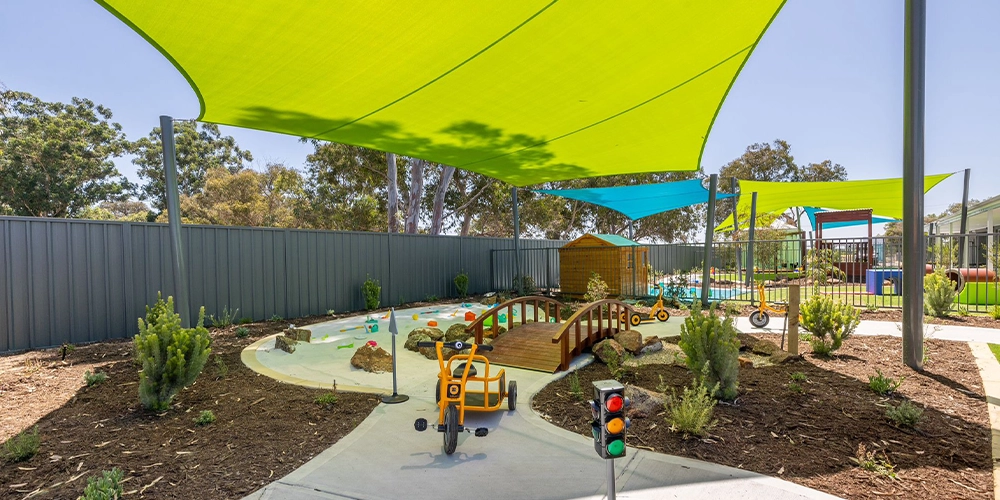
Types of Outdoor Play Areas
Not all outdoor play areas are created equal. Different play areas cater to specific needs, spaces, and preferences. From natural designs to themed play zones, each type serves a unique purpose and provides children with varied opportunities for growth and fun. Below, we explore some of the most popular outdoor play areas, highlighting their features and benefits.
Natural Outdoor Play Areas
A natural outdoor play area incorporates rocks, logs, sand, and plants to create a more organic and immersive play environment. These play areas connect children with nature, foster creativity, and encourage sensory exploration.
- Features:
- Sandboxes, water features, and garden patches.
- Climbing structures are made from logs or tree stumps.
- Open grassy areas for unstructured play.
- Benefits:
- Encourages problem-solving and imaginative play.
- Develops a child’s love for nature and environmental awareness.
Natural play areas are especially popular in schools and Montessori environments, providing hands-on learning opportunities.
Dramatic Outdoor Play Areas
A dramatic outdoor play area is designed to spark imagination and creativity. These spaces often include props, role-play stations, and themed zones where kids can pretend to be anything from shopkeepers to astronauts.
- Example:
- A mini outdoor kitchen with real utensils and pretend food.
- Construction zones with tools and building materials.
These areas help develop social skills as children work together to create stories and scenarios.
Sensory Outdoor Play Areas
A sensory outdoor play area stimulates a child’s senses through textures, sounds, and interactive features. These areas are especially beneficial for toddlers, preschoolers, and children with special needs.
- Key Elements:
- Water play stations for pouring and splashing.
- Textured pathways (smooth, rough, bumpy).
- Music walls with bells, chimes, and drums.
Sensory play fosters cognitive and emotional growth while providing a calming, therapeutic experience.
Outdoor Construction Play Areas
Perfect for older kids, an outdoor construction play area focuses on building and problem-solving activities.
- Equipment Ideas:
- Mini cranes, bricks, and wooden blocks.
- Sand for digging and constructing.
This play area enhances spatial reasoning, teamwork, and motor skills, making it a favorite for kindergartens and large play spaces.
Covered Outdoor Play Areas
A covered outdoor play area ensures children can play comfortably regardless of weather conditions. These areas often include shaded zones, pergolas, or complete enclosures.
- Ideal For:
- Daycares, preschools, and backyard setups.
- Protection from harsh sunlight or rain.
Covered spaces often integrate with other play areas, such as sensory or dramatic zones, to provide flexibility.
| Type | Best For | Key Features |
|---|---|---|
| Natural Outdoor Play Area | Schools, daycares, nature-themed setups | Sand, plants, water, logs, open grassy areas |
| Sensory Outdoor Play Area | Toddlers, preschoolers, special needs children | Water play, music walls, textured pathways |
| Dramatic Outdoor Play Area | Role-play enthusiasts, creativity-focused spaces | Props, mini kitchens, themed role-play zones |
| Construction Play Area | Older kids, teamwork-building activities | Tools, building blocks, sandpits |
| Covered Outdoor Play Area | All age groups, all-weather play | Shaded zones, enclosed spaces |
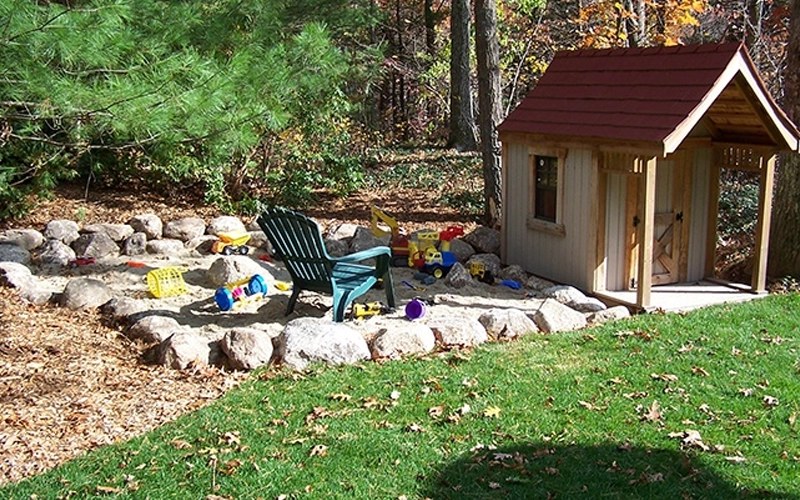
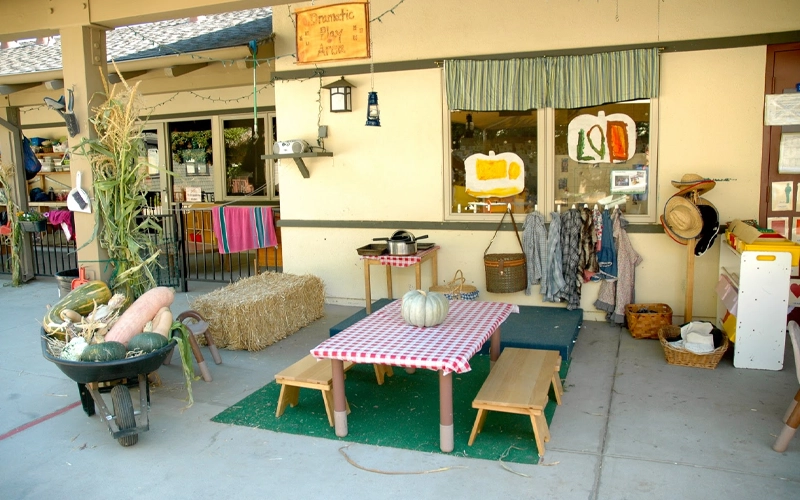

Outdoor Play Area Ideas for Different Spaces
No matter the size or type of space, there’s always a way to create an engaging outdoor play area for children. Whether working with a small backyard or a large community park, these ideas inspire you to make the most of the available area.
Small Backyard
If you have limited space, focus on compact and multifunctional designs.
- Ideas:
- Install a climbing wall along a fence to save space.
- Use stackable features like a slide combined with a sandbox.
- Add portable features like an inflatable outdoor water play area for summer fun.
- Tip: Choose equipment that can double as storage, like a bench with toy compartments.
Daycare
Daycares require diverse play zones to engage children across different age groups.
- Design Tips:
- Create separate zones: a toddler outdoor play area with soft mats and a preschool outdoor play area with climbing frames.
- Add shaded sections for sun protection, like a covered outdoor play area.
- Include sensory and role-play features for variety.
Community Park
Ample outdoor spaces can accommodate a variety of activities and equipment.
- Suggestions:
- Install multiple play zones, such as a natural outdoor play area with sand and water and a separate construction play area.
- Add educational elements, like a mini garden for kids to grow vegetables.
- Include accessible equipment for children of all abilities, such as wheelchair-friendly swings.
Home Daycare
Home daycare providers can create engaging yet budget-friendly setups.
| Feature | Description |
|---|---|
| Small Climbing Structures | Compact, safe climbing frames for toddlers. |
| Outdoor Rubber Mats | A must for safety and easy cleaning. |
| Sensory Table | A small water or sand table for interactive sensory play. |
| Role-Play Props | Add portable items like pretend cooking sets or tools for imaginative activities. |
Large Garden Play Area Ideas
If you have a big backyard or garden, the possibilities are endless.
- Creative Additions:
- Set up a Montessori outdoor play area with self-guided activities like stacking blocks or interactive boards.
- Build an outdoor dramatic play area with a playhouse or puppet theater.
- Add physical challenges, like a rope climbing course or zip line.
Outdoor Play Area Ideas for Schools
Schools can integrate outdoor play areas into their educational programs.
- Best Features:
- Outdoor sensory play areas for younger kids.
- Sports zones with mini soccer goals or basketball hoops.
- Nature-themed outdoor play areas to teach environmental awareness.
Schools can create outdoor play area layouts catering to fun and learning by combining creativity with practicality.
Through thoughtful planning and creativity, you can create diverse outdoor play areas that cater to the needs of children across different spaces and developmental stages. From compact backyard setups to large community playgrounds, the key is to combine fun, safety, and engagement.
Don’t just dream it, design it! Let’s chat about your custom furniture needs!
How to Build or Create an Outdoor Play Area
Designing and building an outdoor play area is an exciting project that brings joy to children while supporting their growth and development. A well-planned play area combines safety, creativity, and functionality, ensuring children have a space to explore, play, and learn. Below is a step-by-step guide to help you create the perfect outdoor play area for kids, whether for a backyard, daycare, school, or community space.
Step 1: Assess the Space and Purpose
The first step in creating an outdoor play area is understanding the available space and its purpose.
- Determine the Age Group:
- For toddlers and infants, prioritize safe, soft, and sensory-friendly elements for an outdoor play area for infants.
- For older kids, include challenging and interactive features like climbing walls or obstacle courses.
- Evaluate the Space:
- Measure the dimensions of the area.
- Identify existing features like trees or slopes that can be incorporated into the design.
Example Use Cases:
- A small outdoor play area might include compact elements like a slide, sandbox, or sensory play table.
- A large outdoor play area can consist of separate zones for different activities, such as an outdoor water play area, a natural zone, and a dramatic play area.
Step 2: Plan the Layout
A functional and safe outdoor play area layout is essential.
- Divide the Area into Zones:
- Active Play Zone: For climbing, swinging, and running activities.
- Sensory Zone: Includes elements like sandpits, water tables, or a sensory outdoor play area.
- Role-Play Zone: Create spaces for imaginative activities, such as outdoor dramatic play or mini-construction areas.
- Shaded Area: Add a covered outdoor play area for resting and protection from the sun or rain.
- Prioritize Safety:
- Leave ample space between equipment to prevent collisions.
- Ensure all pathways are clear and accessible.
Tip: Use sketches or digital tools to plan your layout. Incorporate paths or walkways to connect zones, including benches or seating areas for supervisors or parents.
Step 3: Select Safe and Durable Materials
The choice of materials can significantly impact your outdoor play area’s safety, durability, and appeal.
- Ground Covering:
- Install outdoor rubber mats for play areas to provide cushioning and reduce the risk of injuries.
- Sand, grass, or mulch can be used for natural play areas, but regular maintenance is necessary.
- Play Structures:
- Use wooden outdoor play area equipment for a natural and eco-friendly look. Ensure the wood is treated to prevent rot or splinters.
- Metal or plastic equipment should be weather-resistant and free of sharp edges.
Step 4: Incorporate Creative and Sensory Features
Adding creative and sensory elements enhances the play experience and supports cognitive development.
- Natural Features: Include plants, trees, and rock gardens to create a natural outdoor play area.
- Sensory Play Equipment: Install a sandpit, water table, or textured pathways for a sensory outdoor play area.
- Imaginative Play Zones: Set up props for role-playing, such as a mini outdoor kitchen or construction tools for an outdoor construction play area.
Step 5: Add Safety Features
Safety is a top priority when building an outdoor play area for kids.
- Use fencing to enclose the space and prevent kids from wandering off.
- Install non-slip surfaces, especially in outdoor water play areas.
- Ensure all equipment meets safety standards and perform regular inspections.
Step 6: Maintain and Upgrade the Space
Regular maintenance is essential to ensure the longevity and safety of the play area.
- Check for wear and tear on equipment, especially moving parts like swings or slides.
- Keep the space clean and free of debris.
- Update the area with new features, such as adding a covered outdoor play area or incorporating educational elements like vegetable gardens.
Don’t just dream it, design it! Let’s chat about your custom furniture needs!
Essential Equipment for an Outdoor Play Area
The right equipment transforms an outdoor play area into a space where children can have fun, stay active, and learn. Choosing the right combination of equipment ensures the play area meets the needs of children across different age groups while keeping them engaged and safe.
Climbing and Balancing Equipment
Climbing structures and balance beams are essential for developing motor skills, strength, and coordination.
- Recommended Equipment:
- Monkey bars and rope climbing walls for older kids.
- Low climbing structures for toddlers in a toddler outdoor play area.
- Balance beams and stepping stones for coordination.
Swings and Slides
Swings and slides are classic staples of any outdoor play area.
- Swings:
- Bucket swings for infants and toddlers.
- Standard or tire swings for older children.
- Slides:
- Gentle slopes for young children.
- Spiral or tube slides for more adventurous kids.
Sand and Water Play Features
Adding sand and water elements creates a sensory-rich environment that encourages creativity and exploration.
- Sandpits: Perfect for digging, building, and imaginative play.
- Water Features: Include splash pads, water tables, or small fountains for an outdoor water play area.
Sensory and Educational Features
Sensory equipment helps engage a child’s senses and encourages self-guided learning.
- Music Walls: Add bells, drums, or chimes to create a sound-rich environment.
- Gardens: Allow children to plant flowers or vegetables, fostering a connection with nature.
- Textured Paths: Incorporate paths made from different materials (grass, stones, or wood) to stimulate touch.
Role-Play and Dramatic Play Equipment
Imaginative play fosters creativity and social skills.
- Mini Kitchens: Complete with toy utensils and pretend food.
- Construction Zones: Include building blocks, mini cranes, and outdoor construction play area tools.
Protective and Comfort Features
- Shaded Areas: Install canopies or pergolas to create a covered outdoor play area.
- Benches: Provide seating for adults supervising the play area.
- Fencing: Ensure the space is enclosed to keep children safe.
Your perfect classroom is one click away!
Child Safety Guidelines for Outdoor Activities
Ensuring safety in an outdoor play area is paramount. Children should be free to explore and play while protected from potential hazards. We can create an environment that supports fun and safety by implementing comprehensive safety guidelines.
- Pedestrian Safety: In any outdoor play area, it is crucial to manage pedestrian traffic to prevent accidents. Clear pathways should be established, separating walking areas from active play zones. Installing signs and markings can guide children and adults, reducing the risk of collisions. additionally, teaching children to be aware of their surroundings and look both ways before crossing paths can instill lifelong safety habits. Use soft, impact-absorbing surfaces like rubber mulch or foam mats along pathways to enhance safety. These materials can cushion falls and minimize injuries, providing an added layer of protection. Regularly inspect and maintain these surfaces to ensure they remain in good condition.
- Riding Toys Safety: Riding toys, such as bicycles, scooters, and tricycles, are popular in outdoor play areas. It’s essential to create designated zones for riding toys to prevent accidents. These zones should be flat, free of obstacles, and marked to separate them from pedestrian paths and other play areas. Children should always wear appropriate safety gear when riding toys, including helmets and knee and elbow pads. Ensuring that these toys are the correct size for each child and regularly checking them for wear and tear can prevent accidents caused by equipment failure. Additionally, supervising younger children during riding activities can further enhance safety.
- Water Safety: If your outdoor play area includes water features like splash pads, pools, or fountains, water safety becomes a critical concern. Always supervise children when they are near water, regardless of its depth. Install barriers or fencing around pools and deeper water features to prevent unsupervised access. Non-slip surfaces around water areas can help prevent slips and falls. Additionally, providing life vests or floatation devices for young children can add an extra layer of safety. Educate children about water safety rules, such as not running near pools or pushing others into the water.
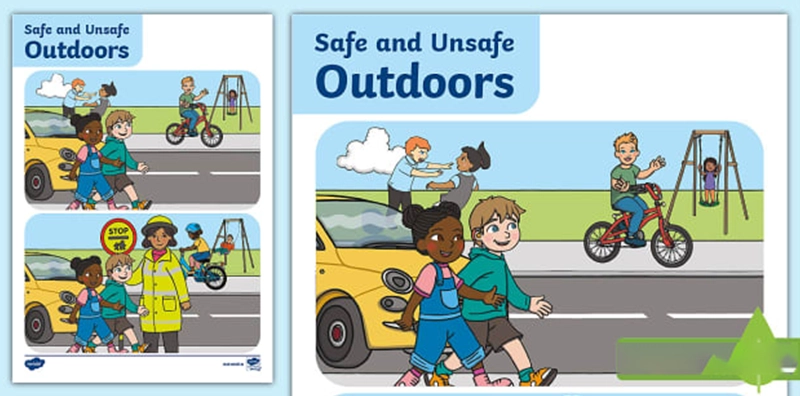
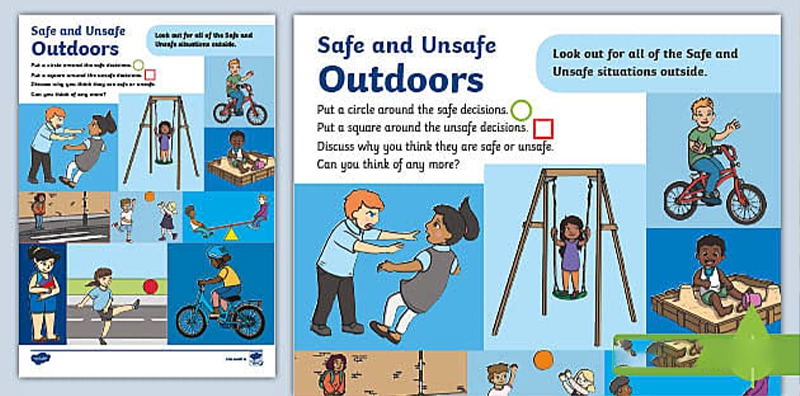
- General Safety Tips: Regular maintenance of the outdoor play area is essential to ensure all equipment and surfaces are safe. Conduct routine checks to identify and fix potential hazards, such as broken equipment, sharp edges, or worn-out surfaces. Keeping the play area clean and free of debris can also prevent injuries. Provide clear safety guidelines and rules for children to follow. These rules should be simple and easy to understand, emphasizing the importance of playing safely and respecting others. Displaying these rules prominently around the play area can be a constant reminder for children and caregivers.
- Emergency Preparedness: Prepare for emergencies by having a first aid kit readily available and ensuring that all supervisors or caregivers are trained in basic first aid and CPR. Knowing how to respond to common injuries, such as cuts, bruises, or sprains, can make a significant difference in the outcome of an accident. A clear emergency plan, including contact information for local emergency services, can expedite response times in case of a severe incident. Regular drills and discussions about emergency procedures can help children and adults know what to do in various situations.
In conclusion, creating a safe outdoor play area involves careful planning and ongoing maintenance. By addressing pedestrian safety, riding toys safety, and water safety, and implementing general safety tips and emergency preparedness, we can provide a secure environment for children to enjoy. Safety should always be a priority, ensuring outdoor play areas allow children to have fun, learn, and grow without unnecessary risks.
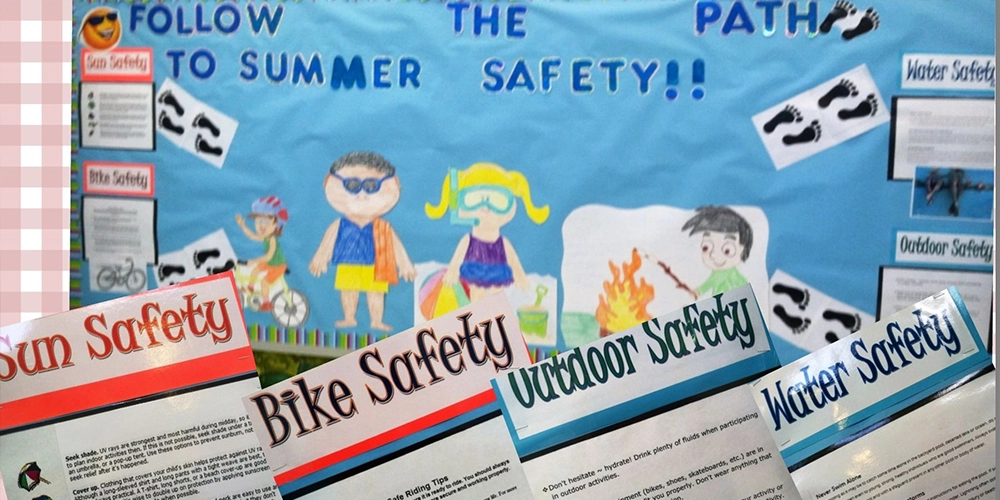
Outdoor Play Areas for Different Age Groups
Designing an outdoor play area tailored to different age groups ensures every child has a safe and engaging environment that suits their developmental needs. From infants to preschoolers and older children, each group benefits from features specifically designed to support their growth and interests. Here, we explore how to create age-appropriate outdoor play areas, combining detailed descriptions with a table for better clarity.
Infants and Toddlers: Safe and Sensory Exploration
For infants and toddlers, safety is the top priority. Their curiosity drives them to explore their surroundings, so providing an outdoor play area for infants and toddlers that encourages sensory engagement and gross motor development is essential.
Key elements include soft surfaces, low climbing structures, and sensory equipment like water tables or sandboxes. Adding outdoor rubber mats for play areas ensures safety during crawling, standing, and first steps. Nursery settings often incorporate colorful and interactive panels, while home setups can include simple climbing ramps and shaded areas.
Preschoolers: Imagination and Active Play
Preschoolers thrive in environments that encourage creativity, active movement, and role-playing. A well-designed preschool outdoor play area incorporates climbing equipment, balance beams, and imaginative elements like outdoor kitchens or dramatic play zones. Features like sensory outdoor play areas with textured pathways or water play stations can stimulate cognitive development.
These play areas should balance physical challenges with opportunities for quiet exploration. For instance, a natural outdoor play area with small gardens or planting zones can nurture an early connection with nature, while swings and slides keep preschoolers physically engaged.
Older Kids: Challenge and Collaboration
As children grow older, they crave more complex and challenging activities. A large outdoor play area for this age group can include obstacle courses, rope climbing walls, and construction zones where they can build and problem-solve. Team-based activities like group swings or cooperative building areas foster social skills and teamwork.
For schools or community setups, a covered outdoor play area ensures year-round usability and protection from the elements, allowing older kids to stay active in any weather.
| Age Group | Recommended Features | Key Considerations |
|---|---|---|
| Infants (0-2 years) | – Soft mats or outdoor rubber mats for play areas. – Low climbing ramps and interactive panels. – Shaded areas for protection. | Ensure all materials are non-toxic, and equipment is low to the ground for safety. |
| Toddlers (2-4 years) | – Sensory elements like sandboxes, water tables, or a sensory outdoor play area. – Small slides and balance beams. | Use brightly colored, interactive features to keep toddlers engaged while ensuring no sharp edges or loose parts. |
| Preschoolers (4-6 years) | – Swings, climbing walls, and dramatic play props like a mini outdoor kitchen. – Textured paths or planting zones. | Combine active play with opportunities for imaginative and educational exploration. |
| Older Kids (6+ years) | – Obstacle courses, zip lines, and group swings. – Cooperative zones like outdoor construction play areas. | Design areas that challenge physical skills and encourage teamwork while ensuring adequate spacing between equipment. |
By tailoring an outdoor play area to specific age groups, you create a space that engages children and supports their developmental milestones. Whether you’re designing a nursery outdoor play area, a preschool outdoor play area, or an ample space for older children, the key is to balance safety, creativity, and functionality. A well-planned setup ensures every child can explore, learn, and grow in an environment built just for them.
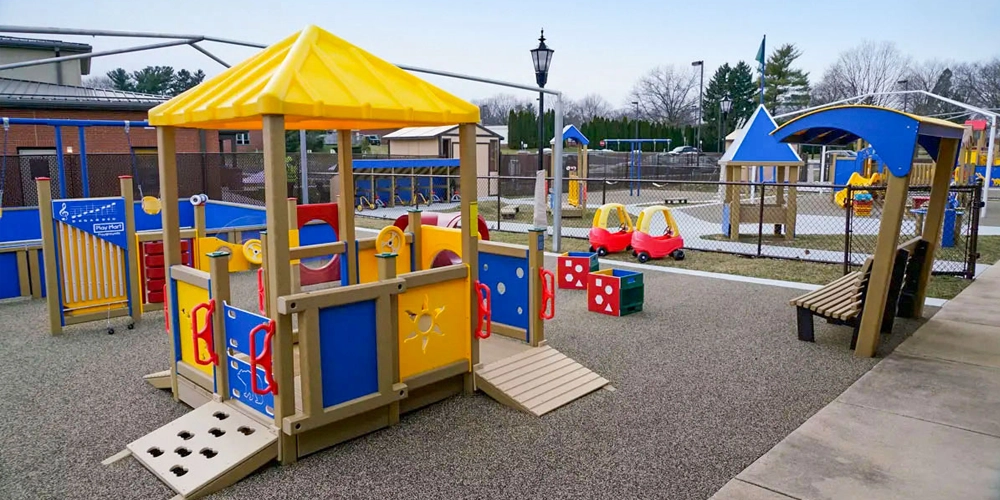
Safety Guidelines and Maintenance Tips
Creating a safe outdoor play area is not just about choosing the right Equipment—it’s about ensuring that every aspect of the space is carefully designed, maintained, and monitored to protect children. Safety should always be the top priority, from regular inspections to proper installation. Below, we explore essential safety guidelines and maintenance tips for keeping your outdoor play area safe and functional for kids.
Safety Guidelines for Daycare and Childcare Outdoor Play Areas
Daycares and childcare centers are responsible for providing a secure environment for children to play. A well-thought-out childcare or daycare outdoor play area should adhere to strict safety standards to prevent injuries and ensure peace of mind for caregivers and parents.
Start by ensuring all Equipment meets safety certifications and is age-appropriate. Low climbing structures, bucket swings, and non-slip surfaces are essential for toddlers and preschoolers. Using outdoor rubber mats for play areas can significantly reduce the risk of injury from falls, especially in active zones with slides or climbing walls. Fencing is another must-have for outdoor play areas in childcare settings, as it keeps children contained and protects them from external hazards, such as stray animals or traffic.
Shaded areas, such as covered outdoor play areas, are critical for preventing sunburn and overheating, especially for younger children more vulnerable to extreme weather conditions. Supervisors should always be present to monitor children, and clear rules should be established to guide their behavior during playtime.
How to Maintain Outdoor Play Area Equipment
Regular maintenance is crucial for ensuring the longevity and safety of your outdoor play area equipment. Weather exposure, wear and tear, and heavy use can degrade Equipment over time, so consistent upkeep is necessary.
- Inspect Equipment Weekly: Check for loose screws, rust, cracks, or sharp edges on slides, swings, and climbing frames. For wooden Equipment in a wooden outdoor play area, inspect for splinters or signs of rotting.
- Clean Regularly: Dirt, debris, and bacteria can accumulate, especially in outdoor water play areas or sandpits. Cleaning these features frequently keeps the area hygienic and safe for children.
- Replace Damaged Parts: To avoid accidents, broken or outdated Equipment should be repaired or replaced immediately.
For natural play areas, regular maintenance includes checking for overgrown plants, hazardous insects, or sharp rocks that might pose a risk to children. In a natural outdoor play area, it’s essential to keep pathways clear and ensure that wooden structures are treated to withstand moisture and pests.
Weather Protection and Seasonal Maintenance
Weather conditions can significantly impact the safety of an outdoor play area. During winter, icy surfaces can become slippery, requiring additional precautions like de-icing pathways and covering exposed Equipment. In summer, UV-protected materials and shade structures, such as pergolas or canopies, keep the space safe for extended use. A covered outdoor play area provides year-round functionality and protects Equipment from weather damage, extending its lifespan.
The Role of Regular Inspections
Scheduled inspections by certified professionals can help identify potential hazards that may not be visible during daily checks. For example, ensuring that outdoor play area equipment complies with safety regulations is especially important in schools and daycare settings. Professionals can evaluate the structural integrity of climbing walls, swings, and other features, ensuring they remain safe for children.
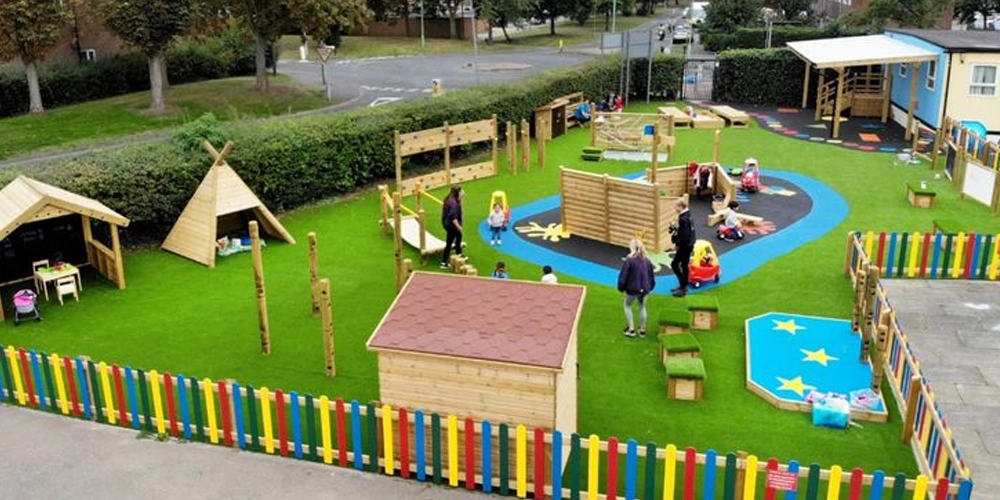
Designing an outdoor play area is more than just creating a space—it’s about shaping a child’s future. These areas provide a unique opportunity for kids to build strength, spark imagination, and connect with others in ways no indoor space can replicate.
Whether it’s a cozy backyard setup or a dynamic daycare outdoor play area, every design choice—no matter how small—contributes to a child’s physical and emotional growth. By prioritizing safety, creativity, and accessibility, you’re not just building a playground but creating a foundation for lifelong exploration, learning, and happiness.
So, take the first step today. With the right tools, thoughtful planning, and a touch of creativity, your perfect outdoor play area awaits!



